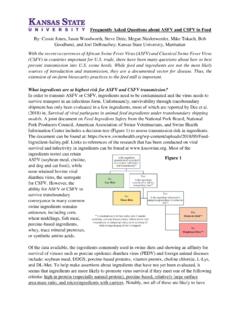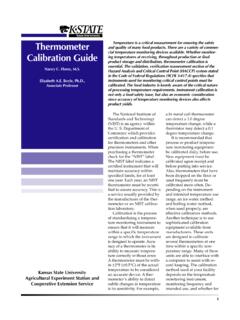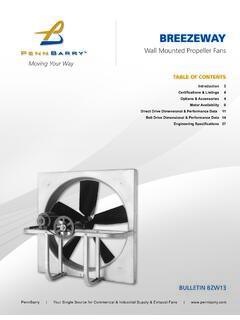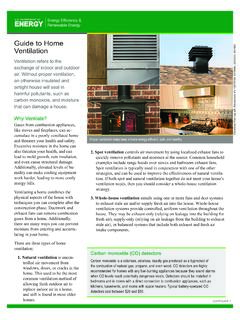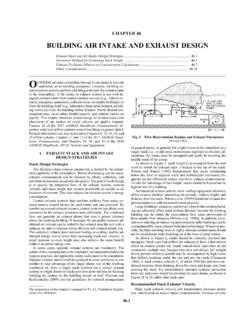Transcription of Fans: Air Flow versus Static Pressure
1 fans : Airflow versus Static Pressure J. Zulovich, University of Missouri J. P. Harner and J. F. Smith, Kansas State University S. Pohl, South Dakota State University TAKE HOME MESSAGES fans of the same diameter are not all created equal. Airflow capacity at different Static pressures varies depending upon fan make and model. Increasing the Static Pressure a fan must operate against reduces the amount of airflow delivered by fan. Use fan performance data to select fans for the specific application and situation. INTRODUCTION All ventilation systems have five functional components: an inlet, an outlet, a driving force, distribution and a path. 1) The inlet provides a location or locations for air to enter the cow space. 2) The outlet provides the location for air to leave the cow space.
2 3) The driving force provides the means to move air into, through, and out of the cow space. 4) Distribution defines how air moves through the cow space. 5) The path must exist so that air can enter the facility, go through the inlet, pass through the cow space, leave through the outlet, and finally exit the facility. If all five functional components exist and are operating properly, the ventilation system probably is working for the given weather and animal stocking conditions. Solutions to most ventilation problems are found by identifying which functional component(s) is missing or improperly operating. LPCV COMPONENTS fans serve as the outlet and driving force in the mechanical ventilation systems in LPCV dairy barns. The inlets are often an evaporative cooling pad or some other inlet components.
3 Distribution is created by the placement of the inlets. Air in an LPCV facility follows a path from the outside, through the inlet evaporative cool cell or other inlet components, under/below various baffles and, finally, out the fans . Understanding the path air takes and how the path interacts with the driving force helps ensure a well-designed and fully-operating LPCV dairy barn ventilation system. Static Pressure Static Pressure is used to evaluate the amount of impact various ventilation system components have on the airflow path within a given system. For mechanical ventilation systems, the fans create positive Static Pressure to move air through a given system. All other components create negative Static Pressure that causes resistance to air moving through a system.
4 A mechanical ventilation system operates with the Static Pressure in balance. The positive Static Pressure created by the fans equals the negative Static Pressure created by resistance as air navigates obstacles in the ventilation path. 2008 Housing of the Future Sioux Falls, SD The unit of measure for Static Pressure is often inches of water (in. water). The Static Pressure of one inch of water is the suction needed to draw water up a straw one inch. For comparison, 1 pound per square inch Static Pressure (1 psi) is equal to in. water Static Pressure . Sometimes Static Pressure is given as Pascals (Pa). The Static Pressure of inches of water (in. water) is equal to about 25 Pascals (Pa). FAN PERFORMANCE fans act as air pumps to move air via the path through a building.
5 Fan designs include different fan blade pitches, distinct number of blades per fan, various operating speeds, and required or provided input motor horsepower. Additional sources can be reviewed to learn more about fan types and design (MWPS-32, 1990). Most agricultural ventilation fans operate at to in. water Static Pressure and deliver a given airflow rate in cubic feet per minute (cfm) at a particular Static Pressure . Some agricultural ventilation fans can effectively operate at Static pressures of up to in. water by delivering a cfm airflow rate similar to the cfm rate at much lower Static pressures. The performance of a fan is defined as the amount of airflow in cfm at a given Static Pressure . The performance of agricultural ventilation fans is tested and reported by the BESS Lab at University of Illinois.
6 The performance and efficiency test results for agricultural ventilation fans can be found at Table 1 shows some example test results for various large diameter fans . VENTILATION DESIGN A ventilation system should be designed by matching the available Static Pressure of an agricultural ventilation fan with the estimated Static Pressure resistance caused by components in the ventilation path. In an LPCV barn, the airflow rate of an exhaust fan and the Static Pressure must equal the total sum of the resistances caused by the inlet system (inlets and evaporative cooling pad), plus the resistance caused by baffles in the barn. If the estimated Static Pressure resistance is greater than the available Static Pressure of the fan, the airflow cfm delivered by the fan decreases until the system pressures match.
7 A matching of the system occurs when the airflow delivered by the fan at a given Static Pressure equals the Static Pressure resistance of the components in the path at the airflow cfm rate delivered by the fan. SUMMARY Fan performance varies amongst different makes, models and manufacturers. Information is available from the BESS lab on performance of different fans . Fan performance decreases as the Static Pressure increases. 2008 Housing of the Future Sioux Falls, SD 2008 Housing of the Future Sioux Falls, SD REFERENCES BESS Lab. Agricultural Ventilation fans , Performance and Efficiencies. Bioenvironmental and Structural Systems Laboratory. Department of Agricultural Engineering, University of Illinois. Urbana-Champaign, IL.
8 ( ) MWPS-32. 1990. Mechanical Ventilating Systems for Livestock Housing. Midwest Plan Service, Iowa State University, Ames. Table 1: Fan Performance Data for Various Large Diameter fans Using Single Phase Motors Fan Airflow (cfm) at Various Static Pressures (in. water) Size Make Motor Size (hp) Test # 48 Acme 07208 2380022900219002060019200 176001570048 Hired Hand 98197 2690025700242002260020900 189001610048 Aerotech 98030 2500023500218001990017600 138009500 54 Airstream 06218 na 308001295002680023900 206001650054 Hired Hand 08154 2870027400258002420022200 198001720054 Aerotech 06141 2950027800260002390021300 182001220055 Aerotech 06129 3080028900270002450021200 169008100 55 Aerotech 06145 na na na 31200228900 2570021700 na test results are not available because capacity exceeded
9 Test chamber equipment. 1 Test result actually for a Static Pressure of in. water 2 Test result actually for a Static Pressure of in. water. Note: Above performance data examples are from all available fan performance data reports from BESS Lab website ( ) accessed on August 20, 2008. The distribution of reports is as follows: 48 fans using 1 phase 230V, 60 Hz - 167 fan performance test reports 48 fans using 3 phase 230V, 60 Hz - 74 fan performance test reports 54 fans using 1 phase 230V, 60 Hz - 53 fan performance test reports 54 fans using 3 phase 230V, 60 Hz - 38 fan performance test reports 55 fans using 1 phase 230V, 60 Hz - 4 fan performance test reports 55 fans using 3 phase 230V, 60 Hz - 4 fan performance test reports

